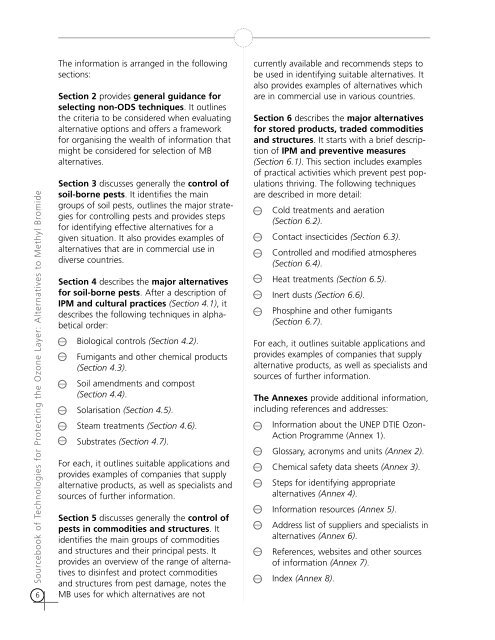Alternatives to Methyl Bromide - DTIE
Alternatives to Methyl Bromide - DTIE
Alternatives to Methyl Bromide - DTIE
Create successful ePaper yourself
Turn your PDF publications into a flip-book with our unique Google optimized e-Paper software.
Sourcebook of Technologies for Protecting the Ozone Layer: <strong>Alternatives</strong> <strong>to</strong> <strong>Methyl</strong> <strong>Bromide</strong><br />
6<br />
The information is arranged in the following<br />
sections:<br />
Section 2 provides general guidance for<br />
selecting non-ODS techniques. It outlines<br />
the criteria <strong>to</strong> be considered when evaluating<br />
alternative options and offers a framework<br />
for organising the wealth of information that<br />
might be considered for selection of MB<br />
alternatives.<br />
Section 3 discusses generally the control of<br />
soil-borne pests. It identifies the main<br />
groups of soil pests, outlines the major strategies<br />
for controlling pests and provides steps<br />
for identifying effective alternatives for a<br />
given situation. It also provides examples of<br />
alternatives that are in commercial use in<br />
diverse countries.<br />
Section 4 describes the major alternatives<br />
for soil-borne pests. After a description of<br />
IPM and cultural practices (Section 4.1), it<br />
describes the following techniques in alphabetical<br />
order:<br />
Biological controls (Section 4.2).<br />
Fumigants and other chemical products<br />
(Section 4.3).<br />
Soil amendments and compost<br />
(Section 4.4).<br />
Solarisation (Section 4.5).<br />
Steam treatments (Section 4.6).<br />
Substrates (Section 4.7).<br />
For each, it outlines suitable applications and<br />
provides examples of companies that supply<br />
alternative products, as well as specialists and<br />
sources of further information.<br />
Section 5 discusses generally the control of<br />
pests in commodities and structures. It<br />
identifies the main groups of commodities<br />
and structures and their principal pests. It<br />
provides an overview of the range of alternatives<br />
<strong>to</strong> disinfest and protect commodities<br />
and structures from pest damage, notes the<br />
MB uses for which alternatives are not<br />
currently available and recommends steps <strong>to</strong><br />
be used in identifying suitable alternatives. It<br />
also provides examples of alternatives which<br />
are in commercial use in various countries.<br />
Section 6 describes the major alternatives<br />
for s<strong>to</strong>red products, traded commodities<br />
and structures. It starts with a brief description<br />
of IPM and preventive measures<br />
(Section 6.1). This section includes examples<br />
of practical activities which prevent pest populations<br />
thriving. The following techniques<br />
are described in more detail:<br />
Cold treatments and aeration<br />
(Section 6.2).<br />
Contact insecticides (Section 6.3).<br />
Controlled and modified atmospheres<br />
(Section 6.4).<br />
Heat treatments (Section 6.5).<br />
Inert dusts (Section 6.6).<br />
Phosphine and other fumigants<br />
(Section 6.7).<br />
For each, it outlines suitable applications and<br />
provides examples of companies that supply<br />
alternative products, as well as specialists and<br />
sources of further information.<br />
The Annexes provide additional information,<br />
including references and addresses:<br />
Information about the UNEP <strong>DTIE</strong> Ozon-<br />
Action Programme (Annex 1).<br />
Glossary, acronyms and units (Annex 2).<br />
Chemical safety data sheets (Annex 3).<br />
Steps for identifying appropriate<br />
alternatives (Annex 4).<br />
Information resources (Annex 5).<br />
Address list of suppliers and specialists in<br />
alternatives (Annex 6).<br />
References, websites and other sources<br />
of information (Annex 7).<br />
Index (Annex 8).
















